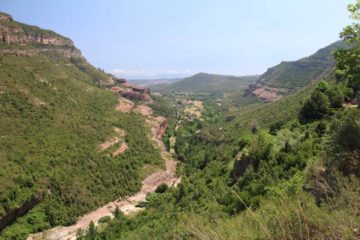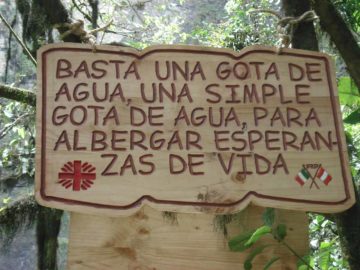About Salt de Tenes (Sant Miquel del Fai)
Salt de Tenes was essentially our lone waterfalling experience near the city of Barcelona though it also had that rare combination of a waterfall juxtaposed with history. However, belying its relative proximity to the cosmopolitan metropolis, the monastery at the Sant Miquel de Fai (which harbored this waterfall) was actually very peaceful and relaxing. This contrasted mightily to the monastery at Montserrat, which was heavily visited and commercialized. In any case, as you can see from this photo, this beautifully-situated tall waterfall was not flowing too well, but at least well enough to show up on photographs. Unfortunately, its neighboring waterfall called Salt de Rossinyol was barely trickling. I think based on our experience, this waterfall was best visited during the early Spring months (March or April) on a year when there’s average or above average rainfall in the region.
Our visit to this waterfall and monastery was pretty straightforward. From the overflow parking area (see directions below), we walked towards a bridge and arched entranceway to a walkway that afforded us views across the Tenes Valley towards our first glimpses of the full height of Salt de Tenes. Had the area seen more recent rainfall, we not only might have seen a thicker Salt de Tenes, but we also might have seen the plunging Salt de Rossinyol spilling right beneath the monastery buildings themselves to our right.

Beyond this pond area, the path continued further along the cliffs as it reached a junction. The path on the left side of the junction went down steps to an intriguing small cave (called La Cueva de Sant Miquel) that featured the typical cave formations of stalactites and stalagmites. More importantly, it highlighted the calcium carbonate (limestone) that was prevalent in the area and provided some of the travertine formations around the waterfalls. There were also very open views towards the Tenes Valley along the stair-stepping trail. Meanwhile, back up at the main path, there was still a water canal along the cliff wall on one side and railings with a few benches on the valley side. On one bench, there was a statue of the writer Josep Pla (carved by artist Tomás Atienza).
The trail then went behind one of the uppermost drops of the Salt de Tenes. The cove here provided welcome shade as well as the cool and refreshing mist from the falling water itself. I’m sure under more waterflow, this area might get even more blasted with water (which I’m sure had given rise to this cove in the first place). Anyways, beyond the falls, the trail continued towards a fork, where the right path went to the hermitage of Sant Martí of the 9th century as well as the Cueva Les Tosques, and the left fork went to a children’s play area where a cantina was also set up to let the adults have a snack and a drink as well as a chat while the kids were further down the ramp playing in a pretty large playground area.
Even though we didn’t see the waterfalls here under the best of conditions, it was very relaxing and peaceful. Indeed, it was the antidote to the fast-paced festive-like atmosphere in and around Barcelona. We wound up spending a couple of hours here, but the walking time was probably no more than an hour.
Related Top 10 Lists
No Posts Found
Trip Planning Resources
Nearby Accommodations
This content is for members only. See Membership Options.Featured Images and Nearby Attractions
This content is for members only. See Membership Options.Visitor Comments:
Got something you'd like to share or say to keep the conversation going? Feel free to leave a comment below...No users have replied to the content on this page
Visitor Reviews of this Waterfall:
If you have a waterfall story or write-up that you'd like to share, feel free to click the button below and fill out the form...No users have submitted a write-up/review of this waterfall






